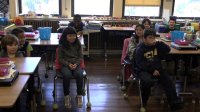Art and Social-Emotional Learning
See a school that partners with local artists to foster positive communication skills in students.
Overview
Encourage Self-Confidence and Creative Expression
Partnerships with local arts organizations can be formal or informal and can occur in school or after school. They can include anything from teaching artists in the classroom, to after-school theater productions, to visual art instruction.
Arts organizations can bring much-needed resources to your students without much cost, and can provide students with new outlets for creativity and ways to develop essential critical thinking and collaboration skills.
Glenview Elementary School, certain gender-based behaviors were getting in the way of learning. As a result, Glenview partnered with two organizations: 51Oakland, a local nonprofit that supports music and arts education, and Glitter and Razz, a nonprofit that teaches SEL skills to girls through creative play. These organizations developed programs to help improve collaboration skills within and across gender lines.
How It's Done
Implementing Arts Partnerships
Developing partnerships with local arts organizations can provide an opportunity for artistic expression, while helping to solve issues that affect school culture. At Glenview, artist-in-residence, Jahi, encourages cultural awareness, self-confidence, and critical thinking through music, art, and poetry. They also partner with Glitter and Razz, a local children's theater and arts group, to develop drama-based programs to help students deal with bullying and peer conflict.
Find the right organization for you.
- Identify your school’s specific needs.
- Establish a clear vision of what the school and the organization want the partnership to accomplish.
- Focus your goals. Don’t try to do too much; pick two things and do them well.
- Have an assessment plan in place to track and quantify impact.
- Make the program as student driven as possible.
Reduce conflict through theatre: Dramatizing conflict and allowing students to role-play different situations can teach healthy conflict resolution.
- Create skits and plays focused on peer conflicts that are common among your particular population of students (consider age, gender, demographics, etc.).
- Work with both mixed- and single-gender groups to address the kinds of issues that are unique to each.
Teach collaboration skills by creating and critiquing each other’s art. Discussing art can also teach students how to communicate without judgment.
- Have students work in a largely unstructured space that supports play, cooperation, and conversation.
- Focus conversations on issues of diversity to help students learn to respect differences.
- Use “Wows and Wonders” such as, “Wow, this makes me think about...” or “I wonder why the artist made this choice,” to help teach how to critique art in a respectful way.
Glenview Elementary
Enrollment
534 | Public, UrbanPer Pupil Expenditures
$7625 School • $17283 District • $13658 StateFree / Reduced Lunch
35%DEMOGRAPHICS:
58% English Language Learners
